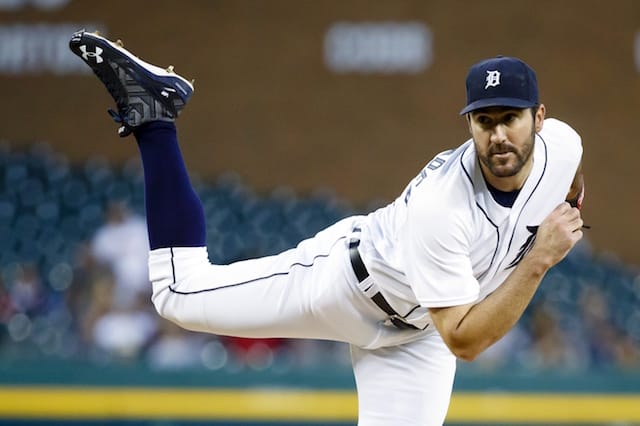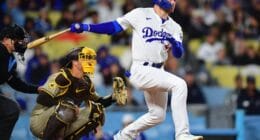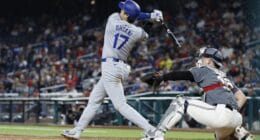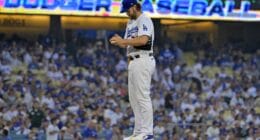The annual General Manger meetings concluded Thursday without a significant trade occurring during the week — hardly a surprise. But that doesn’t mean framework for possible blockbusters down the road weren’t at least discussed by the many executives on hand in Scottsdale, Ariz.
On Thursday, the Los Angeles Dodgers were linked to their first substantive trade rumor of the offseason: a deal for Detroit Tigers ace Justin Verlander is reportedly ‘brewing’ between the two teams.
Verlander, who will turn 34 years old in February, is coming off his best campaign since finishing second in American League Cy Young voting during the 2012 season. In 227.2 innings, the right-hander posted a 3.04 ERA and AL-best 1.00 WHIP with 254 strikeouts to just 57 walks.
A Cy Young Award winner in 2011, Verlander is one of three finalists for the same honor in 2016. In addition to his stellar numbers across the board, he posted a career-high strikeout rate of 28.1 percent and accumulated the most WAR among pitchers with 6.6.
Though Verlander is entering the decline phase of his career, he is still pitching at an elite level. It’s not often starters of this caliber become available in trades, but the Tigers are looking to unload significant salary this offseason.
Not only that, but the organization might be leaning toward a rebuild after two consecutive years without a postseason appearance.
That said, does it make sense for the Dodgers to be pursuing a trade for an aging but top-tier pitcher? Let’s review the pros and cons.
Pros
Workhorse
Verlander began the 2015 season on the disabled list with a right triceps strain — the only stint of such matter in his career. As a result, he only tallied 133.1 innings — the second-lowest total of his career.
Prior to that, Verlander never logged fewer than 186 innings in a season, going back to 2006 in which he was named AL Rookie of the Year.
Over the past 11 seasons, Verlander has averaged 212 innings per year and led the AL in innings pitched on three separate occasions (2009, 2011-12).
That kind of stability could go a long way in the Dodgers rotation, given the question marks that currently surround the club.
After Clayton Kershaw and Kenta Maeda, injury-prone but talented arms Scott Kazmir and Brandon McCarthy are slated to fill out the rotation, though their futures in Los Angeles are uncertain as they’re both trade candidates.
Following Kazmir and McCarthy are former top prospects in Julio Urias and Jose De Leon, but the pair will likely face innings-limits in 2017.
Acquiring someone like Verlander who possesses frontline talent while consistently registering 200 frames should be the goal, and would provide Kershaw a right-handed ace complement for the first time since Zack Greinke signed with the Arizona Diamondbacks.
National League success
Spending his first 12 seasons in Detroit, Verlander has never played for a National League club before. However, his numbers (albeit a small sample size) indicate that he would be dominant in a switch of leagues.
In 255.2 career innings against Interleague competition, Verlander is 27-5 with a 2.99 ERA and 1.14 WHIP. He made five starts in 2016 against NL clubs, posting a solid 3.73 ERA and 1.09 WHIP with 34 punch outs in 31.1 innings.
Moving to the NL and having the benefit of pitching home games at Dodger Stadium will further improve those numbers, not to mention that Verlander will get to face pitchers instead of designated hitters.
Cons
Salary
Verlander is owed $84 million over the next three seasons and has a vesting option for $22 million in 2020 that will be exercised with a top-five Cy Young finish in 2019.
The Dodgers are one of few select teams that can take on that type of salary, but committing such a high amount of money to one player might prevent the team from pursuing other mega deals (e.g., signing Yoenis Cespedes or taking on Ryan Braun’s contract in a trade).
Additionally, there are much cheaper and younger options on the trade market, including Chris Sale and Jose Quintana of the Chicago White Sox, and Chris Archer of the Tampa Bay Rays, that might appeal to the Dodgers more.
Though, those arms would cost remarkably more in terms of prospects.
Age
As mentioned above, Verlander will turn 34 years old prior to Opening Day and will likely start declining soon. He’s under contract for at least three more years, so the Dodgers would essentially be paying for the backend of his career.
That’s not to say that Verlander will suddenly become a bad pitcher, of course. But it would be unfair to expect him to pitch like an ace for the remaining duration of his contract.
The current Dodgers front office has traditionally avoided long-term commitments to aging players, so it’ll be interesting if they’ll make an exception this time around. They nearly did so to sign Greinke.
With a limited free-agent market, the Dodgers will need to make an impact trade to improve the front-end of the starting rotation — or stay pat and look toward next season’s non-waiver trade deadline for potential upgrades.
Whether a deal for Verlander is consummated remains to be seen, but it’s evident that the Dodgers are exploring all avenues on vastly improving a team that was two wins away from the World Series this season.





